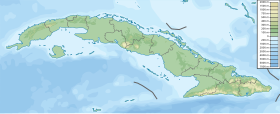User:RenaatPeeters/sandbox
Cayo Confites | |
|---|---|
Lighthouse | |
Location of Cayo confites in Cuba | |
| Coordinates: 22°11′01″N 77°39′42″W / 22.18361°N 77.66167°W | |
| Country | |
| Province | Ciego de Ávila |
| Municipality | Morón |
| Elevation | 2 m (7 ft) |
| Time zone | UTC-5 (EST) |
| Area code | +53 |
Cayo Confites is a cay on the northern coast of Cuba, in the municipality of Nuevitas, Camagüey Province. It has an area of 2 km².
Geography
[edit]This island forms a part of the Jardines del Rey archipelago, and is located east of Cayo Cruz and surrounded by the Atlantic Ocean. It's a small key no longer than three United States city blocks and one block wide.[1] It is composed of rough rock and coral. There is a lighthouse on the island.[2]
History
[edit]The island is known for its military base that housed a revolutionary army in 1947 to fight against Rafael Trujillo: the expedition of Cayo Confites. In the post-war period, neighboring countries opposed Trujillo's dictatorial regime and devised the plan to overthrow his regime. Ramón Grau, the president of Cuba, supported the action. When Trujillo got wind of the plans, he threatened to bomb Santiago de Cuba and Havana. The Cuban military staff, however, opposed the actions of the revolutionaries and confiscated their weapons. When the American pilots were ordered to return the US, the action was called off.
De cafés en restaurants die uitkeken op het nieuwe Capitolio plaatsten tafels en stoelen op het voetpad voor hun zaak. Op deze terrassen in de openlucht traden ’s avonds zangers en artiesten op. Aanvankelijk van tafel tot tafel, later geörganiseerd in aangekondigde evenementen. Er werden grote zonneweringen aan de gevels opgehangen waardoor men minder hinder ondervond van de westelijke avondzon die recht op deze gevels scheen.
Het aaneengesloten geheel van overdekte terrassen tegenover het Capitolio werd een belangrijke toeristische trekpleister. Hotel Saratogo lag op de rand van dit gebied, maar slaagde erin om bezoekers te lokken door het plaatsen van een grote glazen luifel of ‘marquisa’ voor het gebouw en grote luidsprekers die de aandacht trokken.
Op deze Aires Libres traden groepen als Anacaona en zangers als Benny More op. De vele radiostations zonden vaak life uit vanaf de terrassen zoals radio Garcia-Serra.

